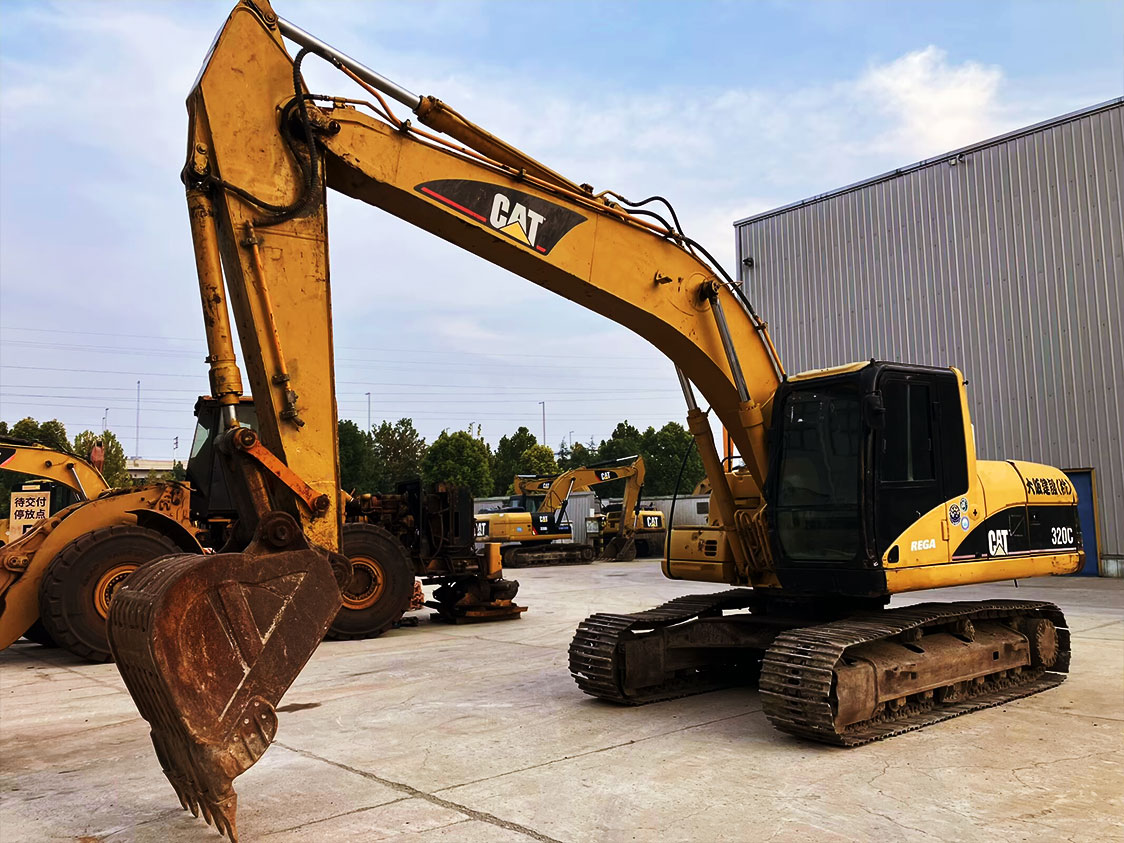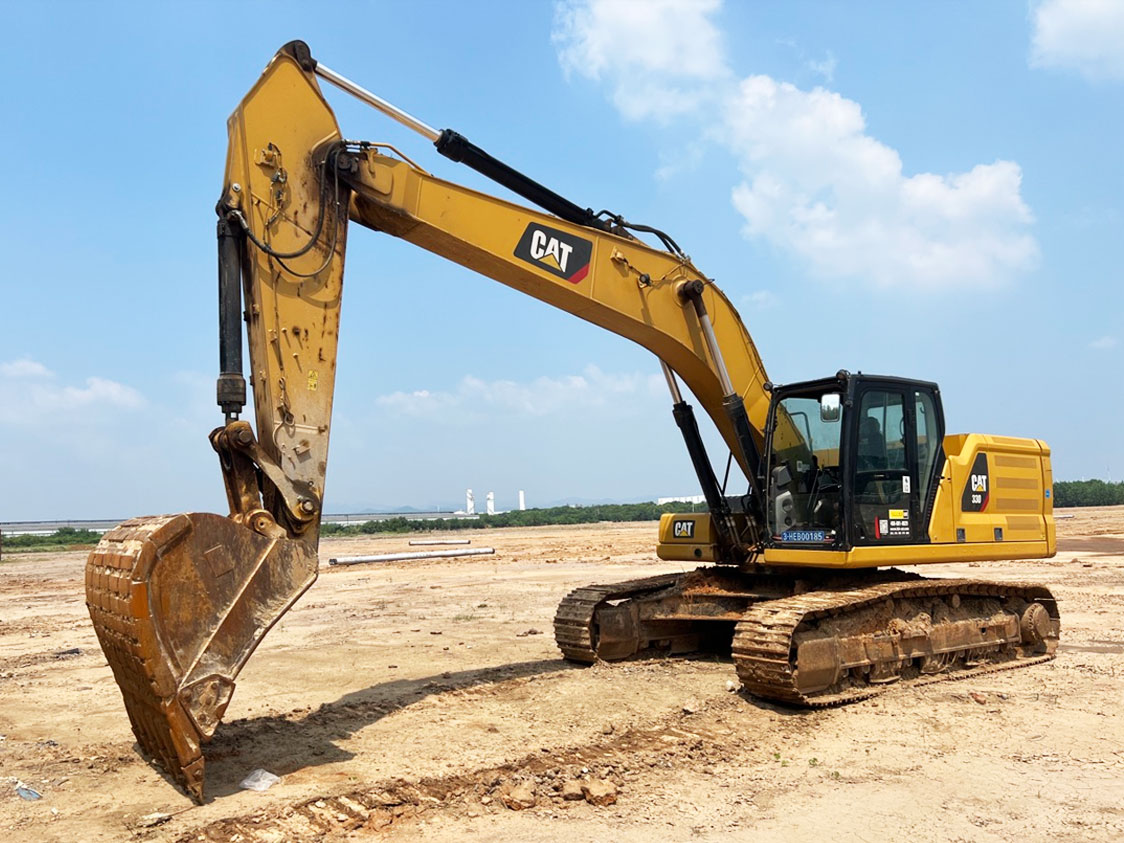Analysis of common faults of construction machinery in winter: hydraulic excavator drive
When using construction machinery in winter, the oil circuit, gas circuit, and cooling pipeline are prone to various faults due to the cold weather. These faults are basically related to "ice" (the specific reasons are shown in the following examples). This should be taken seriously during use so that the fault can be eliminated in a timely and smooth manner.

(1) Thermostat failure. A YZ10B roller was found to have a "boiling" phenomenon in the water tank within a short period of time after the diesel engine was started. The water chamber under the water tank was checked and felt very cold, indicating that the cooling water was not fully circulated. After disassembling and inspecting the thermostat, it was found that there were ice cubes in the thermostat, which prevented the main valve from opening, resulting in the inability of the cooling water to circulate in a large amount, causing the engine water temperature to rise too quickly and "boiling" phenomenon.
(2) Gas circuit blockage. A ZL50 loader was found to have a zero pressure gauge after starting; no gas was discharged when the air tank vent switch was opened; gas was discharged when the air pipe between the compressor and the gas control valve was disassembled, indicating that the air pump was working normally. After disassembling and inspecting the air pipe between the gas control valve and the air tank, it was found that there was a small ice block at the connection between the copper air pipe and the rubber hose, which blocked the air pipe, preventing the gas from entering the air tank, and thus the barometer had no indication. In winter, the water vapor in the brake air circuit often freezes into ice after shutdown, causing the air pipe to be blocked. Therefore, the water in the air tank and the oil-water separator must be drained after each shutdown.
(3) The filter is blocked. A W4-60 excavator stalled shortly after starting. The oil was pumped with a manual pump to remove the air in the fuel line. It still stalled shortly after starting again. The oil pipe from the fuel tank to the fuel pump and the oil pipe from the fuel pump to the diesel filter were checked, and there was no blockage. The diesel filter was disassembled and inspected, and the filter element was found to be frozen. The main reason was that the engine was shut down and sealed in the autumn without seasonal maintenance. The original diesel had a high freezing point. In winter, the diesel in the filter froze and almost sealed the filter element. Although it could barely start, it stalled due to filter blockage and insufficient diesel supply. After the ice in the filter was cleared and the diesel was replaced, the diesel engine resumed normal operation when it was restarted.
(4) Hydraulic oil freezing. A ZL50 loader was found to have a torque converter oil pressure (outlet pressure) of 0 and a speed control oil pressure of 0.5Mpa (normal value is 1.08-1.47 Mpa) after starting. The machine could not start after shifting gears. The transmission oil filler cap was opened and it was found that the hydraulic oil had frozen into ice slag (waxy). The transmission, filter and main oil pipeline were then baked with a blowtorch. When it was restarted, the pressure of each instrument was normal and the machine could run normally.
(5) Diesel freezing. A Shanghai 120A bulldozer suddenly ignited and stalled while leveling the site. When pumping oil with a manual pump, only a small amount of oil flows out from the bleed screw of the injection pump; check the diesel tank, the oil is sufficient, but there are ice slags (wax) in the diesel; check the pipeline from the diesel tank to the oil pump, and find that there are also ice slags in the pipe, which causes the oil to flow poorly. The reason is that the original diesel tank was filled with 0# diesel, which caused the machine to freeze during winter operation. After cleaning the oil circuit and replacing it with low-freezing point diesel, the diesel engine resumed normal operation and never stalled.
1. Common faults of the drive axle
The drive axle is composed of the main reducer, differential, bridge housing, half shaft, wheel reducer and wheel hub. Its function is to transmit the torque from the drive shaft to the drive wheels to change the direction of rotation, reduce speed and increase torque.
Requirements for the drive axle:
(1) During assembly, the specified clearance should be retained for the matching motion pairs of the bearings, main reducer and wheel reducer to prevent the parts from getting stuck due to heat expansion during operation and to ensure that the working surface of the parts has a sufficiently thick oil film. The maximum clearance after the gear teeth are worn shall not exceed 0.4mm; the active and passive gear teeth of the main reducer shall have correct meshing marks.
(2) Good lubrication conditions should be met, that is, suitable lubricating oil and specified liquid level height, and no oil leakage should occur.
The drive axle bears large and complex forces. Long-term use will cause inevitable wear of various parts. In addition, improper use or maintenance will deteriorate the technical condition of the drive axle. When the drive axle is working, abnormal noise, oil leakage, overheating or other phenomena will occur.
2. Abnormal noise of the drive axle
1. Abnormal noise of the drive axle is a manifestation of deterioration of the technical condition. The size of the noise indicates the degree of deterioration of the technical headquarters. The abnormal noise and timing of the rear axle are also different. Abnormal noise generally changes with the driving speed and driving conditions of the excavator.
2. Cause Analysis
(1) Gear wear When the excavator is driving, the reducer (main reducer and wheel-side reducer) and differential gear of the drive axle will wear. When the lubrication is poor, the gear wears faster. After the gear teeth are worn, they lose the involute outer contour geometry. When the gears are meshing, the rolling friction is reduced and the sliding friction is increased. This not only increases the meshing clearance of the gears, but also further accelerates the wear process of the gears, generating noise, i.e. abnormal sound. In addition, the gear teeth are like a cantilever beam. The bending stress generated at the root of the tooth is the largest after being loaded. In addition, due to the influence of alternating loads, fatigue cracks will often occur at the root of the gear. As the working time increases, the fatigue degree increases and the cracks expand; when the gear teeth are meshing, the lubricating oil will be squeezed into the cracks of the meshing teeth, and the cracks will extend in depth and length under the action of the oil pressure. When the gear bearing capacity is less than the load, it will break, commonly known as tooth hitting. After tooth hitting, the abnormal sound will be louder, and it may even interrupt the transmission or damage other parts.
(2) There are gaskets behind the axle gears and planetary gears of the differential. When these gaskets are worn and thin, the meshing clearance of the differential gears will increase, resulting in abnormal meshing and noise during operation.
(3) When the axle spline teeth are worn, the matching clearance will also increase. When the speed difference occurs between the two mating parts during transmission, the spline and keyway will collide and make abnormal noise.
(4) The influence of bearings. Bearings are mostly subjected to alternating loads. When working, they will not only wear out, but also fatigue the rolling elements and raceway surfaces. When lubrication is poor, the damage speed is accelerated and the degree of damage is further aggravated. Therefore, when the rolling elements of the bearings roll, they produce irregular rolling and vibrating noise. The preload of the tapered bearing is adjusted by the gasket or thread (differential bearing). If the preload is adjusted too small, the axial movement of the tapered gear will cause the meshing clearance to increase and decrease, and the correct meshing will be lost and abnormal noise will be emitted. The noise will be louder when damaged, and even the moving parts will be stuck.
(5) If the fasteners (bolts) of the reducer and differential are loose, abnormal noise will be generated.
(6) Poor lubrication Gear transmission must be lubricated. If there is a lack of oil or the oil is of poor quality and no oil film is formed, dry friction will form when the gear teeth are meshing, which will cause abnormal noise.
(7) Improper assembly When the main reducer and differential of the drive axle are matched, a certain gap should be left between the matching parts of the gears and bearings. If the gap is too large, abnormal noise will be generated; if the gap is too small, the oil film on the gear teeth will be easily squeezed when the gears are meshing, affecting the lubrication and cooling of the tooth surface, causing the metal tooth surfaces to contact directly, forming dry friction and generating high heat. Instantaneous high temperature will be formed during transmission, and the two meshing tooth surfaces will stick together, and scars will form on the metal tooth surfaces along the relative sliding direction, which is called biting. At this time, the gears work unsteadily and generate a lot of vibration and noise.
When the main and driven gears of the reducer are meshing, there should be a correct meshing mark to ensure good meshing. If the meshing marks of the gear teeth are not evenly distributed around the pitch line, the excavator will make abnormal noises when driving.

3. Diagnosis and elimination
During diagnosis, the abnormal noise should be eliminated according to the timing and characteristics of the abnormal noise and the reasons analyzed above.
(1) When the road test excavator is driving in a straight line, the abnormal noise is usually caused by the main reducer or differential bearing; when turning, the abnormal noise is usually caused by the differential.
① If the noise is loud (screaming) and it is newly assembled, the differential part of the drive axle housing feels hot when the hand model is used, indicating that it is mostly caused by over-tightening and too small clearance.
② If the noise is heard after long-term use, it is generally caused by excessive wear of various parts and excessive clearance. It is often manifested as a "click" sound when starting or changing the speed. If a dry friction sound is heard, it is mostly caused by poor lubrication in the drive axle.
(2) Parking inspection can be carried out by hand or clearance measuring instrument.
① Use a clearance meter to check the total transmission clearance of the drive axle. The method is: put the transmission lever in the neutral position, release the parking brake, brake the wheel, fix the scale of the clearance meter on the reducer housing, and fix the pointer on the connecting flange of the drive shaft. Turn the drive shaft from one extreme position to another. The angle value measured is the total angular clearance of the drive axle, that is, the meshing clearance of the main reducer gear, the meshing clearance of the differential gear, the matching clearance of the half-axle and half-axle gears, and the meshing clearance of the wheel-side reducer gear. It should generally be around 65°. If the measured angle is too large, it means that the abnormal noise of the drive axle is caused by the excessive clearance of its transmission parts.
② Check the lubrication condition. Remove the oil plane screw plug and check the oil plane height. If there is too little oil or the oil is deteriorating, it means that the abnormal noise is caused by poor lubrication.
③ Check the temperature. When you hear a high-pitched sound from the drive axle while driving, you can touch the temperature of the drive axle main reducer housing, differential housing, and wheel reducer housing with your hand. If there is overheating, it means that the assembly is too tight. Generally, this phenomenon occurs in new or repaired drive axles.
When the drive axle fault is finally confirmed, it should be disassembled for inspection and eliminated accordingly. For example, when the bearing is damaged after disassembly, it should be replaced. When the preload is small, it should be adjusted according to the actual situation. If the main reducer or differential meshing clearance is too large, or the meshing mark is incorrect, it should be adjusted. When adjusting the meshing mark, refer to the adjustment method of the loader meshing mark. When the gear teeth are damaged, they should be replaced. Generally, gears should be replaced in pairs. If they are not replaced in pairs, not only will there be abnormal noise after replacement, but it will also affect the service life of the gears.
3. Drive axle oil leakage
1. Phenomenon
Drive upper axle oil leakage refers to the leakage of lubricating oil to the outside of the drive axle housing, and there are obvious oil marks.
2. Cause Analysis
Oil leakage is always caused by poor sealing. The main reasons for poor sealing are as follows:
(1) The joint surface of the housing joint is uneven, the connecting screws are loose or the sealing gasket is damaged.
(2) Damage to the oil seal (see the description of the transmission for the cause of damage) or wear of the journal causes poor sealing and oil leakage.
(3) Oil leakage from threaded holes is mostly caused by loose screws or damaged thread buckles.
3. Diagnosis and elimination
Oil leakage from the drive axle can be visually seen as leaking oil. According to the analyzed cause, the symptomatic elimination is carried out.
IV. Overheating of the drive axle reducer
1. Phenomenon
After the excavator has traveled a certain mileage, the moving parts in the drive axle are subjected to relative sliding friction, thus generating a certain temperature. It should not feel hot when touched by hand, otherwise it is considered to be overheated.
2. Cause Analysis
The main transmission parts in the drive housing mainly include the main reducer, differential and wheel reducer. The main reducer and differential are connected together and concentrated in the middle of the drive axle. There is sliding friction when this part is working.
Under normal circumstances, the surface of the mating parts in the drive axle that move relative to each other should have a layer of lubricating oil film as a medium to prevent the two parts from direct contact and friction. This not only delays the wear process of the parts, but also reduces the heat generated by friction. Through the flow of lubricating oil, the heat generated by the friction of the parts can be taken away and dissipated, so that the temperature of the main transmission part in the drive axle can be reduced to maintain a normal temperature. Otherwise, the two mating parts in the drive axle will produce semi-dry friction or dry friction due to lack of lubricating oil during relative movement, and the friction coefficient will increase accordingly, and the friction force will also increase accordingly, and the temperature will rise. Due to the poor heat dissipation caused by the lack of lubricating oil, the temperature of the parts cannot be dissipated and accumulates. The higher the speed of the parts and the longer the time, the higher the temperature. It can be seen that the overheating of the main transmission part of the drive axle is caused by direct friction between the working surfaces of the two relatively moving parts. The reasons why direct friction can occur are: first, there is no lubricating oil or too little lubricating oil; second, although there is enough lubricating oil, the clearance is too small, the gear teeth are squeezed too tightly when the gears are meshed, so that the gear teeth cannot form an oil film on the surface and direct friction occurs; third, when overloaded, the mating parts press each other too much, which breaks the oil film on the surface of the parts and causes direct friction and overheating. Fourth, the quality of the lubricating oil deteriorates, making it difficult to form an oil film on the surface of the parts, and the two parts will have direct friction and overheat.
3. Diagnosis and troubleshooting
(1) If the drive axle overheats when used after repair, it is very likely that the assembly is too tight, and it should be checked and adjusted.
(2) If the overheating is caused by long-term uphill driving, most of the time it is caused by heavy load driving for too long, so you should stop and rest.
(3) If it is found that the overheating is caused by poor lubrication, the symptomatic treatment should be eliminated. For example, when the lubricating oil is insufficient, it should be replenished, and when the lubricating oil is deteriorated, it should be replaced.
V. Other faults
The other faults mentioned here mainly refer to the twisting or breaking of the half shaft and the damage of the wheel reducer.
(1) The following are the reasons for the twisting or breaking of the half-axle:
① The working site of the excavator is relatively bad, often with pits and unevenness, and the half-axle is often subjected to impact loads. When the impact load on the half-axle exceeds the material strength of the half-axle, the half-axle will break.
② The half-axle is congenitally insufficient. When manufacturing the half-axle, if there are processing defects or cracks, its load-bearing capacity will be reduced, and it will often break when overloaded.
③ Due to the long-term use of the half-axle, fatigue cracks are inevitable. Fatigue cracks will often extend with the extension of the use time until they finally break.
④ Improper selection of half-axle materials will often cause the half-axle to twist into a twist shape when overloaded.
2 When the wheel reducer is overloaded, it is easy to cause damage; when the lubrication is poor, the wear process of the machine parts is accelerated, resulting in early damage.








